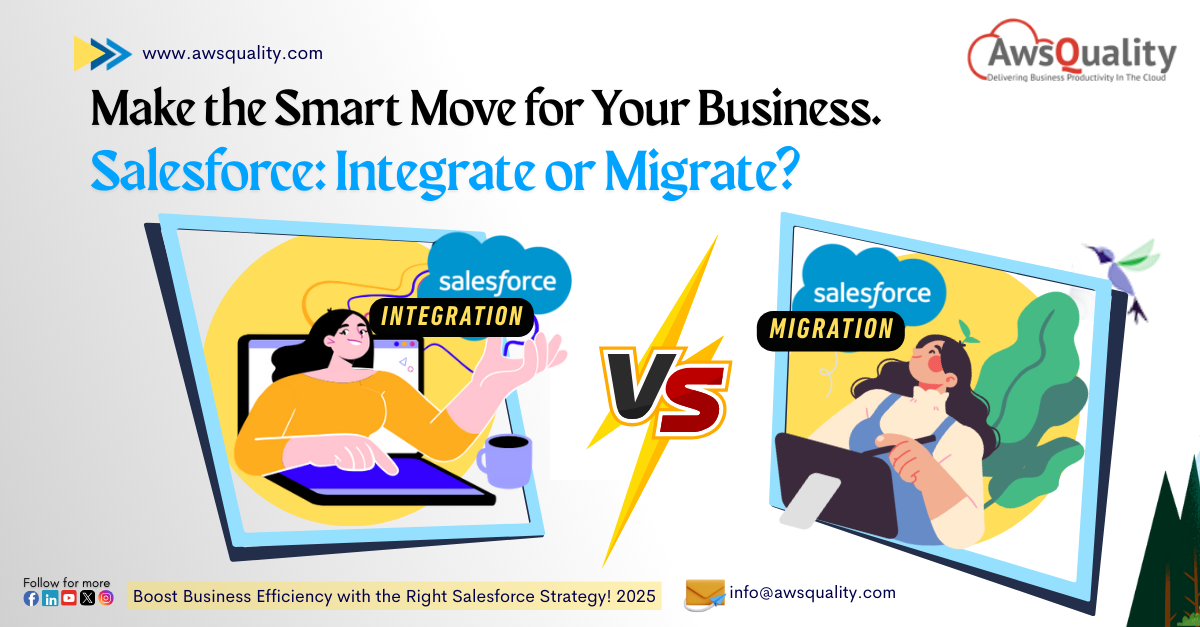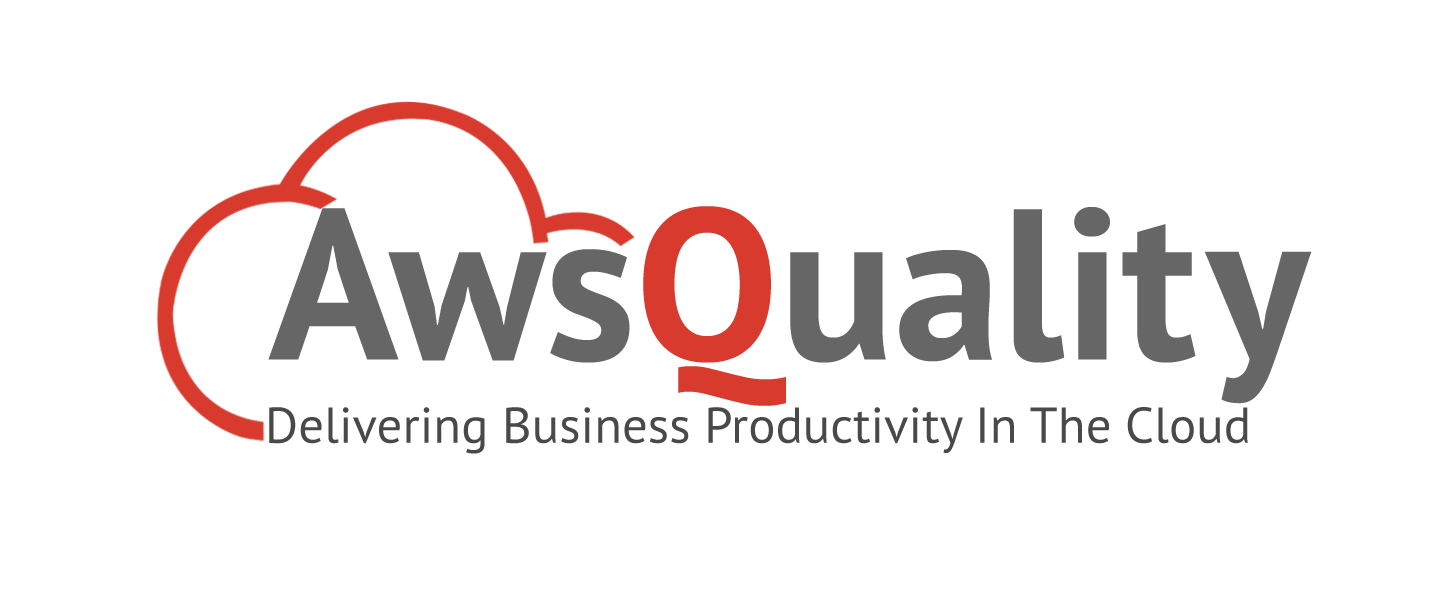
In today’s rapidly evolving business landscape, leveraging robust Customer Relationship Management (CRM) systems like Salesforce is crucial for maintaining a competitive edge. However, businesses often face a critical decision: should they integrate Salesforce with their existing systems or migrate entirely to Salesforce? This comprehensive guide with AwsQuality as top salesforce consulting partner in uae or middle east, delves into the nuances of Salesforce integration and migration, helping you determine the best strategy for your business.
Understanding Salesforce Integration and Migration
Salesforce Integration involves connecting Salesforce with other existing systems within your organization to enable seamless data exchange and streamlined workflows. This approach is ideal for businesses looking to enhance their current systems without a complete overhaul. Integration ensures real-time data sharing, improves customer insights and enhances operational efficiency.
Salesforce Migration, on the other hand, entails transferring data and processes from a legacy system to Salesforce. This strategy is suitable for organisations aiming to replace outdated systems with Salesforce’s advanced functionalities, ensuring data accuracy, accessibility and modernisation.
Factors to Consider When Choosing Between Integration and Migration
When deciding between integration and migration, consider the following key factors:
1. Business Objectives
- Integration: Ideal for enhancing and extending the capabilities of existing systems without replacing them.
- Migration: Suitable for organisations seeking to replace obsolete systems with a comprehensive CRM solution like Salesforce.
2. System Compatibility
Assess whether your current systems can seamlessly integrate with Salesforce. If significant compatibility issues exist, migration might be the more viable option.
3. Budget and Resources
- Integration can be more cost-effective in the short term, utilizing existing infrastructure.
- Migration may require a higher initial investment but can lead to long-term savings through improved efficiency and reduced maintenance costs.
4. Data Volume and Complexity
For organisations with complex, unstructured, or large volumes of data, migration offers an opportunity to clean and organise data within a unified system.
5. Operational Impact
- Integration typically causes minimal disruption, allowing continued use of current systems during implementation.
- Migration may involve temporary downtime but results in a more streamlined and modernised operation.
6. Long-Term Vision
If scalability and future growth are priorities, migration to Salesforce provides a robust platform that can evolve with your business needs.
Long-Term Benefits of Migration vs. Integration with Salesforce consulting partner
Migration Benefits
- Scalability: Salesforce offers a scalable platform that grows with your business.
- Modernization: Transitioning to Salesforce replaces outdated systems with state-of-the-art CRM functionalities.
- Efficiency: Consolidating data into a single system eliminates redundancies and streamlines workflows.
- Data Accuracy: Migration allows for data cleansing, ensuring accuracy and reliability.
- Comprehensive Analytics: A centralised platform enables deeper insights through advanced reporting and analytics tools.
Integration Benefits
- Cost-Effectiveness: Integration leverages existing systems, often resulting in lower initial costs.
- Flexibility: Maintain the use of systems that are already effective while enhancing them with Salesforce’s capabilities.
- Minimal Disruption: Integration is typically less disruptive to daily operations.
- Enhanced Collaboration: Connecting various systems fosters better communication and teamwork.
- Real-Time Data Exchange: Ensures consistent and up-to-date information across platforms.
Cost Considerations
Migration Costs
- Data Migration: Costs depend on data volume and complexity.
- Customisation: Tailoring Salesforce to specific business needs can incur additional expenses.
- Training and Support: Educating staff and providing ongoing support are essential investments.
- Licensing Fees: Salesforce licenses vary by edition and user count.
Integration Costs
- System Integration: Expenses depend on the number and complexity of systems being connected.
- Third-Party Tools: Utilising additional tools or APIs may increase costs.
- Maintenance: Ongoing maintenance and updates are necessary to ensure continued performance.
Strategies to Reduce Costs
For Migration
- Assess Data Needs: Migrate only essential data to minimize scope.
- Pre-Migration Cleanup: Cleanse data beforehand to reduce restructuring efforts.
- Use Automation Tools: Leverage tools like Salesforce Data Loader to automate processes.
- Phased Migration: Implement in stages to spread costs over time.
- Internal Expertise: Utilise in-house teams to reduce reliance on external consultants.
For Integration
- API-First Approach: Utilise Salesforce’s pre-built APIs to avoid custom development.
- Choose the Right Tools: Select cost-effective third-party integration tools.
- Focus on Key Integrations: Prioritize integrations that offer the most value.
- Reuse Existing Resources: Leverage current IT infrastructure and skills.
- Plan for Scalability: Design frameworks that can be easily expanded.
Best Practices for Salesforce Data Migration
- Define Clear Goals: Establish what data needs to be migrated and why.
- Data Assessment: Audit and clean data to ensure accuracy and relevance.
- Plan the Migration: Develop a detailed roadmap, including timelines and responsibilities.
- Test Thoroughly: Conduct test migrations to identify and resolve potential issues.
- Monitor Post-Migration: Continuously evaluate performance and data integrity.
- User Training: Ensure users are well-trained to maximise platform adoption.
Conclusion,
Choosing between Salesforce integration and migration depends on your organisation’s unique needs, goals and resources. While integration offers flexibility and cost-efficiency, migration provides a long-term solution with enhanced capabilities and scalability. By carefully evaluating your current systems, business objectives and long-term vision, you can select the strategy that best positions your business for success.
Whether you opt for integration or migration, partnering with an experienced Salesforce consulting partner can ensure a smooth transition and maximise your CRM investment. Contact us at info@awsquality.com or sales@awsquality.com for knowledgeable Salesforce advice.
Short FAQ
- What is Salesforce Data Migration?
It’s the process of transferring data from a legacy system or another CRM to Salesforce. - What is Salesforce Integration?
It’s the process of connecting Salesforce to other systems or tools for seamless data sharing. - When should I choose data migration over integration?
Choose migration if you’re replacing outdated systems entirely. Opt for integration if you’re enhancing existing systems by linking them to Salesforce. - What tools can I use for migration and integration?
For migration: Salesforce Data Loader, MuleSoft, etc.
For integration: APIs, MuleSoft. Zapier or Salesforce-native connectors. - How long does data migration or integration take?
Migration timelines depend on the volume and complexity of data but generally range from weeks to months. Integration may vary depending on the number of systems involved. - Which advantages come with working with a Salesforce Consulting Partner?
Implementation is streamlined by knowledgeable partners like AwsQuality, guaranteeing increased efficiency and return on investment. - What are the benefits of Salesforce migration?
Modernization, scalability, data accuracy and improved analytics. - What are the benefits of Salesforce integration?
Real-time data sharing, cost-effectiveness, enhanced workflows and minimal disruption. - What are common challenges in migration and integration?
For migration: Data inconsistency, downtime.
For integration: System compatibility issues, security concerns. - How can I reduce costs for migration or integration?
Plan strategically, clean data in advance, use pre-built tools and prioritise critical features.




